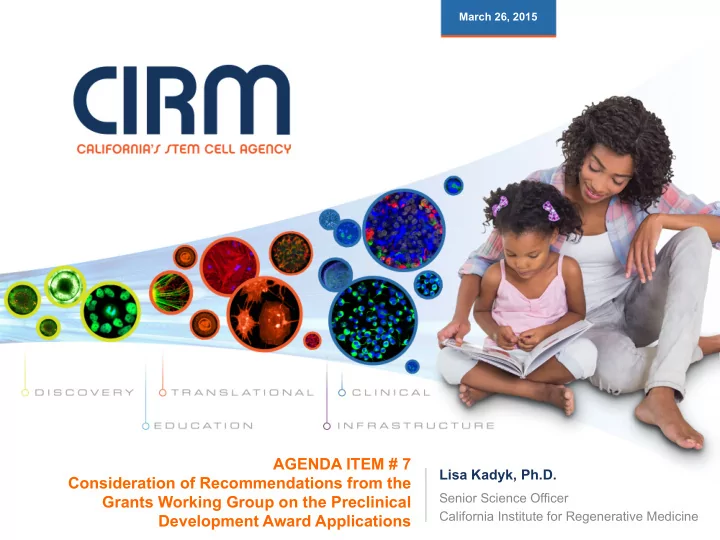

March 26, 2015 AGENDA ITEM # 7 Lisa Kadyk, Ph.D. Consideration of Recommendations from the Senior Science Officer Grants Working Group on the Preclinical California Institute for Regenerative Medicine Development Award Applications
PCD Awards: Purpose (Candidate) ¡ Phases ¡2-‑3 ¡ Preclinical ¡ Phase ¡1 ¡Clinical ¡ Basic ¡ Discovery ¡ Clinical ¡ Preclinical ¡Dev. ¡ Research ¡ Research ¡ Research ¡ Research ¡ Research ¡ Research ¡ File Pre-IND POC Select (DC) Complete Complete IND mtg Ph 1 Ph 2-3 Early ¡Transla>onal ¡Research ¡ PA ¡15-‑01 ¡ PA ¡15-‑02 ¡ Preclin ¡Dev ¡ § Fund early preclinical development of successful stem-cell based translational projects. § Upon successful completion of award: ready for PA 15-01, Late-Stage Preclinical Development. § Final RFA issued under the “1.0” process.
PCD Awards: Eligibility Two key scientific eligibility criteria: Development Candidate (DC) ü A single DC that derives from or targets stem cells. Readiness ü Convincing, reproducible disease-modifying activity in relevant models ü Preliminary assessments of safety, mechanism-of-action ü Reproducible, scalable research-grade production of candidate
PCD Awards: Objective and Scope Objective: Carry out activities needed to conduct a well-prepared pre-IND meeting with the FDA at the end of the award In-Scope Activities: • GMP manufacturing process development • Dose, regimen, route of administration studies • Pharmacokinetic, pilot safety and mechanism of action studies • Selection of target indication • Preparation of clinical development plan, draft protocol • Conduct of pre-IND meeting with FDA
PCD Awards: Funding Information Award Information Up to $40M total, 5 to 8 awards • 30 months, up to $5-8M justifiable total project costs • Co-Funding 1:1 matching funding required if DC not identified with prior CIRM • funding 5 3/24/15
PCD Awards: Review Criteria Highlights 1) Should the proposed therapeutic be developed? § Significance: Competitive with standard of care § Scientific Rationale: Potential for clinical benefit in targeted indication 2) Can the proposed plan achieve the RFA Objective? § Readiness: Convincing preclinical efficacy, preliminary safety and mechanism-of- action, reproducible production of DC § Design and Feasibility: Project plan complete, timeline realistic § Assets, Collaborations, Environment: MTAs, patents, contracts, equipment and facilities. 3) Is this the right team to execute the plan? § PI and Team: Experience in team leadership, preclinical development
Scoring by Grants Working Group (GWG) § Tier 1 (scores ≥ 75): recommended for funding § Tier 2 (scores 65-74): moderate quality or consensus on merit not reached § Tier 3 (scores ≤ 64): not recommended for funding
PCD Priorities for Programmatic Consideration The following priority areas were called out in the RFA: • Cell therapies, especially if derived from pluripotent stem cells or directly reprogrammed cells • Potentially transformative approaches to unmet medical needs • 25% co-funding (if DC identified using CIRM funding) • 1:1 industry co-funding (if DC not identified using CIRM funding)
CIRM Recommendations and Rationale Tier 1 Applications: Fund § CIRM supports the GWG assessment § Five awards, $15.8MM § $3.25MM co-funding Tier 2 and Tier 3 Applications: Do not fund § Applicants may consider submitting improved proposals, addressing review comments § Opportunities: § CIRM 2.0 Translational/Early Preclinical program announcement (anticipated for Summer 2015) § PA 15-01 Partnering Opportunity for Late Stage Preclinical Projects (Open Now)
Recommend
More recommend